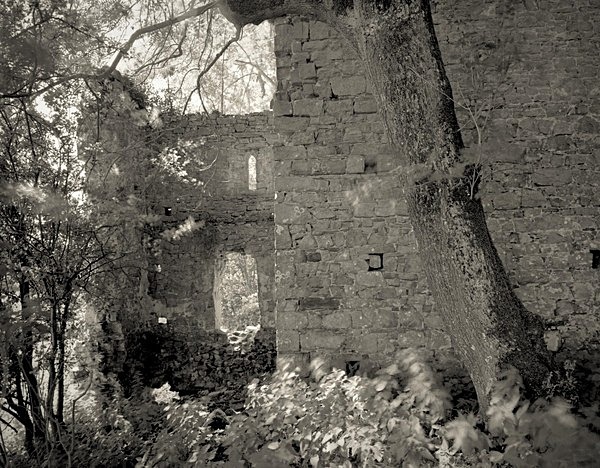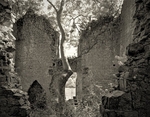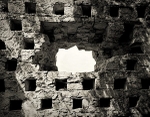EAST ORCHARD CASTLE, St Athan, Vale of Glamorgan 2020
Return to: THE GLAMORGANS (Including Neath Port Talbot, Gower, Vale of Glamorgan) or RUINS THROUGHOUT WALES or Galleries

Notes on East Orchard Castle, St Athan, Vale of Glamorgan 2020
Revisited: Summer 2020, foliage higher but the site had a different feel than the winter visit of 2019. It was a hot day, a flying visit, only four sheets of film, viewpoints had to be chosen carefully.
Built in the 14th century and then demolished in the 1756, East Orchard is an impressive site. I like these types of ruin, off the tourist radar but large and wealthy of atmosphere and photographic viewpoints. The site consists of the castle (unfortified and considered more so as a domestic dwelling), a chapel, barn, kitchen and dovecote. All are in remarkably good condition considering the age of the site. I arrived late afternoon, not long before the sun was to set and I had to work quickly to get the viewpoints I considered the more worthy. I focussed firstly upon the house; large, three storey possible basement – fragments remain but high fragments, perhaps void of detail but a general sense of the size and statue of the place can be easily sensed. It reminded me much of other sites in South Wales such as Old Bouston Manor, Boverton Place, Llantrihyd Place... all large, all old and long dismantled but with much remaining. All are also, I believe, privately owned. East Orchard is reached by a footpath alongside the B4265 just east of St Athan. Right at the beginning of the path there is an old air raid bunker in good condition. The path carries on for quarter of a mile through field, thicket, hedgerow and hardwood trees set within a few shallow hollows to the chapel and then less than fifty yards to the house itself. The house sits on the side of a bank – the barn and dovecote are higher up overlooking the house.
East Orchard is a striking place; I was accompanied by birdsong, a few bleating sheep and an encroaching twilight. The afternoon was peaceful and thankfully so after a semi-stressful morning at work. I was in a bad mood and this visit was the tonic I needed. That’s said, it didn't necessarily improve my mood but neither did it make it any worse. It was good to breathe out in the open, my time outside much diminished since I moved to Swansea.
Of the buildings, there are few tell-tale signs that the chapel was indeed a chapel. It is long and narrow and it is just about apparent one gable end that there was a large window. It is possibly the least well-preserved of all the larger buildings on-site. The house is large, overlooking both Thaw River/Afon Ddawan and a large tarmac factory with high chimneys and is set in the bank with fine views. It's an imposing building but a quiet location - that said the sound of traffic was just about noticeable. A few images were captured, not wholly satisfactory but documented nonetheless. Doorways and windows offered viewpoints, framing the landscape around. Small aircraft flew overhead every five or ten minutes, breaking up the peace, a contrast between old and new, a reminder that civilisation is never more than a few minutes away.
The dovecote was in an excellent condition but the barn less-so, the A-frames had come down within and much of the roof had collapsed. A few more exposures made - a few sheets of film and there's always a sense of fear that the film will be ruined one way or another until it is developed. I guard this exposed film with great care. Only once it is developed, washed and dried can I consider the visit complete and a success.
Within the hour it was dark and I found myself back on the road moving at a snail’s pace along the M4 through Port Talbot wondering why there were so many cars on the road all times of the day. The memory of the house remained with me for the rest of the evening and indeed through to the next morning too. During quiet times I often return to a site, imagining it is much the same, depending on the time year and then, as in the case of East Orchard, flipping back the decade upon decade, attempting to imagine how is slowly decayed since it was dismantled. Did I visit at the optimum time of deterioration? Of course not. But am I satisfied when I did visit? Yes I am. I had known of this site for many years. Why hadn’t I visited years ago? I have many notes of places/ruins to visit. What had taken me so long to visit East Orchard? I am not sure. Perhaps because my notes are not collated and are scattered from attic to computer file to scrap pieces of paper and notepads. I am also fully aware that my one hour visit is the tiniest of fraction compared to the 250 years since the house had been dismantled.
Revisited: Summer 2020, foliage higher but the site had a different feel than the winter visit of 2019. It was a hot day, a flying visit, only four sheets of film, viewpoints had to be chosen carefully.
Built in the 14th century and then demolished in the 1756, East Orchard is an impressive site. I like these types of ruin, off the tourist radar but large and wealthy of atmosphere and photographic viewpoints. The site consists of the castle (unfortified and considered more so as a domestic dwelling), a chapel, barn, kitchen and dovecote. All are in remarkably good condition considering the age of the site. I arrived late afternoon, not long before the sun was to set and I had to work quickly to get the viewpoints I considered the more worthy. I focussed firstly upon the house; large, three storey possible basement – fragments remain but high fragments, perhaps void of detail but a general sense of the size and statue of the place can be easily sensed. It reminded me much of other sites in South Wales such as Old Bouston Manor, Boverton Place, Llantrihyd Place... all large, all old and long dismantled but with much remaining. All are also, I believe, privately owned. East Orchard is reached by a footpath alongside the B4265 just east of St Athan. Right at the beginning of the path there is an old air raid bunker in good condition. The path carries on for quarter of a mile through field, thicket, hedgerow and hardwood trees set within a few shallow hollows to the chapel and then less than fifty yards to the house itself. The house sits on the side of a bank – the barn and dovecote are higher up overlooking the house.
East Orchard is a striking place; I was accompanied by birdsong, a few bleating sheep and an encroaching twilight. The afternoon was peaceful and thankfully so after a semi-stressful morning at work. I was in a bad mood and this visit was the tonic I needed. That’s said, it didn't necessarily improve my mood but neither did it make it any worse. It was good to breathe out in the open, my time outside much diminished since I moved to Swansea.
Of the buildings, there are few tell-tale signs that the chapel was indeed a chapel. It is long and narrow and it is just about apparent one gable end that there was a large window. It is possibly the least well-preserved of all the larger buildings on-site. The house is large, overlooking both Thaw River/Afon Ddawan and a large tarmac factory with high chimneys and is set in the bank with fine views. It's an imposing building but a quiet location - that said the sound of traffic was just about noticeable. A few images were captured, not wholly satisfactory but documented nonetheless. Doorways and windows offered viewpoints, framing the landscape around. Small aircraft flew overhead every five or ten minutes, breaking up the peace, a contrast between old and new, a reminder that civilisation is never more than a few minutes away.
The dovecote was in an excellent condition but the barn less-so, the A-frames had come down within and much of the roof had collapsed. A few more exposures made - a few sheets of film and there's always a sense of fear that the film will be ruined one way or another until it is developed. I guard this exposed film with great care. Only once it is developed, washed and dried can I consider the visit complete and a success.
Within the hour it was dark and I found myself back on the road moving at a snail’s pace along the M4 through Port Talbot wondering why there were so many cars on the road all times of the day. The memory of the house remained with me for the rest of the evening and indeed through to the next morning too. During quiet times I often return to a site, imagining it is much the same, depending on the time year and then, as in the case of East Orchard, flipping back the decade upon decade, attempting to imagine how is slowly decayed since it was dismantled. Did I visit at the optimum time of deterioration? Of course not. But am I satisfied when I did visit? Yes I am. I had known of this site for many years. Why hadn’t I visited years ago? I have many notes of places/ruins to visit. What had taken me so long to visit East Orchard? I am not sure. Perhaps because my notes are not collated and are scattered from attic to computer file to scrap pieces of paper and notepads. I am also fully aware that my one hour visit is the tiniest of fraction compared to the 250 years since the house had been dismantled.

|
Return to: THE GLAMORGANS (Including Neath Port Talbot, Gower, Vale of Glamorgan) or RUINS THROUGHOUT WALES or Galleries
